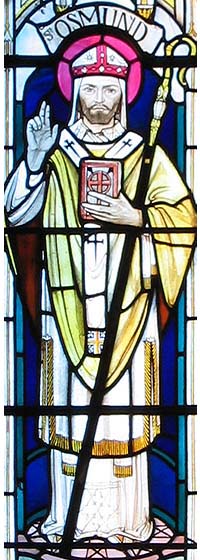
EBK Home
Kingdoms
Royalty
Saints
Pedigrees
Archaeology
King Arthur
Adversaries
Mail David
 St. Osmund De
Seez,
St. Osmund De
Seez,Bishop of Salisbury
(c.1050-1099)
Osmund, afterwards St. Osmund, was one of the great patrons of Salisbury. He completed the cathedral at Old Sarum which his predecessor had only time to commence.
Osmund's background is obscure. He was the son of Count Henry of Seez but also appears to have been a close relation of the Conqueror, traditionally his mother was Lady Isabella of Normandy, one of King William's many half-siblings. Already Lord of Seez, Osmund, was supposedly created Earl of Dorset or Somerset after the Conquest. He became Castellan of Old Sarum, but subsequently embraced the ecclesiastical life - possibly in order to receive the bishopric for which his noble birth and unusual learning especially qualified him. He became a Royal Chaplain before being promoted to Chancellor in 1072. Six years later, he was made Bishop of Salisbury.
As Bishop, Osmund compiled the Consuetudinarium, or "Ordinal of Offices," for use at Sarum. This arrangement was rendered necessary by the variations introduced by the numerous foreign ecclesiastics who settled in this country after the Conquest and subsequently became the model throughout the south of England. The original ritual is still preserved in the Cathedral at Salisbury. Bishop Osmund seems to have been a somewhat severe prelate. "Rigid in the detection of his own faults," says William of Malmesbury, "he was unsparing towards those of others." He was present at the Council of Rockingham in 1094, in which, influenced perhaps by his blood-ties, he took the side of William Ruffus against Anselm of Canterbury, for which he afterwards received absolution from the Archbishop.
Bishop Osmund died on 4th December 1099 and was buried in the Cathedral at Old Sarum. His tomb and remains were removed to the new cathedral after its completion and, toward the end of the fourteenth century, the reputation of Bishop Osmund's miracles became so widely spread that after due consultation the Chapter of Salisbury determined to make an application to the Pope for his canonization. This was finally announced by Pope Callixtus III (the first of the Borgias) in 1456, but not until very considerable sums "for the expedition of the bull" had found their way into the Roman exchequer.
Edited from Richard John King's "Handbook to the Cathedrals of England: Southern Division" (1903).
